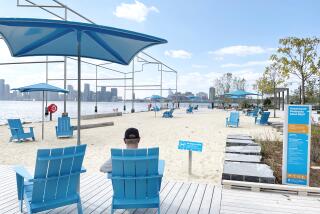Sand Bar Was Once a Glorious Island
- Share via
MOTT'S CREEK, N. J. — At low tide, a sand bar peeks out from under the ocean at the mouth of New Jersey’s Great Bay, the last remnant of an American Atlantis.
Evelyn Suter recalls when that sand bar was a magnificent island, a dreamy sort of a place with families and beautiful cedar trees and tales of haunted hotels.
Suter, who turns 83 this month, was one of the children who told those ghost stories on Tucker’s Island.
And she may be the last person alive who can tell from personal experience the story of the island, which was swallowed by the sea more than half a century ago.
It’s a story with a lesson, a reminder that man may live on the Earth and even manipulate it, but, in the end, does not control it.
“It was a wonderful place,” Suter said of her childhood home. “But now it’s gone to the bottom of the Atlantic Ocean.”
In its glory years, as far back as the late 1700s, Tucker’s Island was 5 miles long and a mile wide. It boasted a lighthouse, two hotels and a school and was a popular spot for sportsmen and vacationers from Philadelphia.
The island, north of Atlantic City along the New Jersey coast, was named for Rueben Tucker, a Quaker from New York who bought it in 1765. According to John Bailey Lloyd, a historian who has written about the lost island in two books, wealthy Quakers gathered there for religious retreats in the years following the American Revolution.
The island was renamed Sea Haven in the 1870s, when there were plans to develop it into a major resort. Those plans were shelved when the nearby town of Beach Haven, on another island a few miles to the north, proved to be too much competition.
Sea Haven’s fate as a commercial enterprise was sealed in 1886, when the Pennsylvania Railroad ran a line across Barnegat Bay onto Long Beach Island, Lloyd said. The tracks ended at Beach Haven and were never extended.
In 1913, when Suter arrived at age 7, the only residents of the once-bustling island were a lighthouse keeper, the staff of a lifesaving station and their families. The Columbia and St. Alban’s hotels had long since closed.
“I remember these two big hotels in disrepair,” Suter said. “We kids would say they were haunted.”
During her first winter there, she lived in a bungalow with her mother and father, who worked at the lifesaving station, rescuing shipwrecked sailors.
The family spent a second winter on the island in a houseboat that Suter’s father towed across the bay from Parkertown.
“We stayed there from September to June,” Suter said. “We didn’t stay in the summer, because there weren’t that many shipwrecks.
Suter recalls attending a one-room schoolhouse on the island in 1913 and 1914, with about six other children. She has fond memories of walking the desolate beaches with her mother, and going fishing in her father’s garvey, a small scow.
On blustery winter nights, everyone would gather at the lifesaving station, the center of the island’s social life.
“They had a gramophone and people would sing and dance,” she said. “Nowadays, people get bored if they don’t have a television set. But we had wonderful times.”
Those times ended in 1915, when the lifesaving station was disbanded and the Coast Guard took over Tucker’s Island. The family moved back to its house across the bay in Parkertown, where Suter had been born and still lives today.
Although no one knew it at the time, the island’s days were numbered. On Feb. 4, 1920, a storm ripped an inlet through Tucker’s Beach, a narrow strip of sand that formed the tip of Long Beach Island and protected Tucker’s Island from the fury of the ocean.
Over the next five years, the inlet widened to the south, consuming Tucker’s Beach and exposing Tucker’s Island to the open sea. The relentless ocean began chewing up the island and, one by one, its buildings.
In 1927, the Little Egg Harbor Light House, which had stood for nearly a century, tumbled into the sea. The ever-encroaching ocean forced the Coast Guard to evacuate the island in 1930, according to Lloyd.
Tucker’s Island officially ceased to exist in 1932, when Long Beach Township removed it from the tax rolls. But a small piece of land where the little schoolhouse stood survived until 1938, when it was swept away during a winter storm.
Now, only the sand bar is left, and many people Suter meets find it hard to believe that so picturesque an island ever stood there.
“People will argue with me about Tucker’s Island,” she said. “But I always tell them, ‘I know what it was really like. I lived there.’ ”
More to Read
Sign up for Essential California
The most important California stories and recommendations in your inbox every morning.
You may occasionally receive promotional content from the Los Angeles Times.













